Class 12: Physics Chapter 13 solutions. Complete Class 12 Physics Chapter 13 Notes.
Contents
NCERT Solutions for 12th Class Physics: Chapter 13-Nuclei
NCERT 12th Physics Chapter 13, Class 12 Physics Chapter 13 solutions
Question 1.
(a) Two stable isotopes of lithium

and

have respective abundances of 7.5% and 92.5%. These isotopes have masses 6.01512 u and 7.01600 u respectively. Find the atomic mass of lithium.
(b) Boron has two stable isotope.s,

and

Their respective masses are 10.01294 u and 11.00931 u, and the atomic mass of boron is
10.811 u. Find the abundances of

and

.
Solution:
Abundance of

is 7.5% and abundance

(b) Let abundance of

x% than abundance of

will be (100 – x)%.
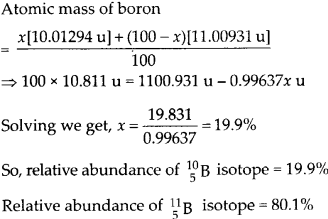
Question 2.
The three stable isotopes of neon :

,

and have respective abundances of 90.51%, 0.27% and 9.22%. The atomic masses of the three isotopes are 19.99 u, 20.99 u and 21.99 u, respectively. Obtain the average atomic mass of neon.
Solution:
Average atomic mass of neon with the given abundances,

Question 3.
Obtain the binding energy (in MeV) of a nitrogen nucleus

, given m

= 14.00307 u
Solution:
The nucleus contains 7 protons and
Question 4.
Obtain the binding energy of the nuclei

and

in units of MeV from the following data:

= 55.934939 u

= 208.980388 u
Solution:
Let us first find the binding energy of


NCERT 12th Physics Chapter 13, Class 12 Physics Chapter 13 solutions
Question 5.
A given coin has a mass of 3.0 g. Calculate the nuclear energy that would be required to separate all the neutrons and protons from each other. For simplicity assume that the
coin is entirely made of

atoms (of mass 62.92960 u).
Solution:
Let us first find the B.E. of each copper nucleus and then we can find binding energy

Question 6.
Write nuclear reaction equations for
(i) a-decay of

(ii) a-decay of

(iii) p-decay of

(iv) p-decay of

(v) p+-decay of

(vi) p+-decay of

(vii) Electron capture of

Solution:

NCERT 12th Physics Chapter 13, Class 12 Physics Chapter 13 solutions
Question 7.
A radioactive isotope has a half-life of T years. How long will it take the activity to reduce to
(a) 3.125%
(b) 1% of its original value?
Required time, as cannot be solved by direct calculation as in part (a).
Solution:


Required time, as cannot be solved by direct calculation as in part (a)

Question 8.
The normal activity of living carbon-containing matter is found to be about 15 decays per minute for every gram of carbon. This activity arises from the small proportion of radioactive

present with the stable carbon isotope

. When the organism is dead, its interaction with the atmosphere (which maintains the above equilibrium activity) ceases and its activity begins to drop. From the known half-life (5730 years) of

, and the measured activity, the age of the specimen can be approximately estimated. This is the principle of

dating used in archaeology. Suppose a specimen from Mohenjodaro gives an activity of 9 decays per minute per gram of carbon. Estimate the approximate age of the Indus-Valley civilization.
Solution:
In order to estimate age, let us first find the activity ratio in form of time ‘t’. Given normal activity, R0 = 15 decays min-1 Present activity, R = 9 decays min-1, Tin = 5730 years Since activity is proportional to the number of radioactive atoms, therefore,

NCERT 12th Physics Chapter 13, Class 12 Physics Chapter 13 solutions
Question 9.
Obtain the amount of  necessary to provide a radioactive source of 8.0 mCi strength. The half-life of
necessary to provide a radioactive source of 8.0 mCi strength. The half-life of

is 5.3 years.
Solution:
Here rate of disintegration required


As 1 mole i.e., 60 g of cobalt contains 6.023 × 1023 atoms, so, the mass of cobalt required for given rate of disintegration

Question 10.
The half-life of

is 28 years. What is the disintegration rate of 15 mg of this isotope?
Solution:

Question 11.
Obtain approximately the ratio of the nuclear radii of the gold isotope

and the silver isotope

.
Solution:
We know the radius of nucleus depend upon mass number ‘A’

Question 12.
Find the Q-value and the kinetic energy of the emitted a-particle in the a-decay of
(a)

and (b)

.
Given

= 226.02540 u,

= 222.01750 u,

= 220.01137 u,

= 216.00189 u, and
mx = 4.00260 u.
Solution:

Question 13.
The radionuclide “C decays according to

+ e+ + v: T1/2 = 20.3 min
The maximum energy of the emitted positron is 0.960 MeV.
Given the mass values:

= 11.011434 u

= 11.009305 u
Calculate Q and compare it with the maximum energy of the positron emitted.
Solution:
The given equation

As we know that different positrons comes out with different possible energies shared between daughter nucleus and positron.
So, the Q value of reaction is almost same as the maximum energy of positron emitted.
Question 14.
The nucleus

decays by β– emission. Write t down the β– decay equation and determine
r the maximum kinetic energy of the electrons emitted. Given that:

= 22.994466 amu,

= 22.989770 amu.
Solution:
The β– decay of

may be explained as
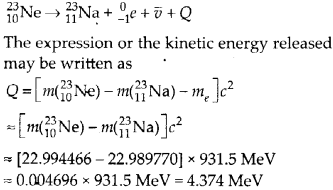
As

is massive, the kinetic energy released is mainly shared by electron-positron pair. When the neutrino carries no energy, the electron has a maximum kinetic energy equal to 4.374 MeV.
Question 15.
The Q value of a nuclear reaction A + b—>C+d is defined by Q = [mA + mb-mc– md] c2, where the masses refer to the respective nuclei, Determine from the given data the Q-value of the following reactions and state whether the reactions are exothermic or endothermic.
(i)

(ii)

Atomic masses are given to be

Solution:
(i) Let us find the Q value in given first equation,
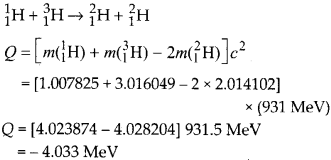
Negative Q value shows that reaction is endothermic.
(ii) Q value in the given second equation
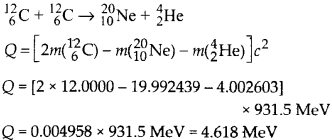
Positive Q shows that the reaction is exothermic.
Question 16.
Suppose, we think of fission of a

nucleus into two equal fragments,

. IS the fission energetically possible? Argue by working out Q of the process.
Given,

= 55.93494 u
and

= 27.98191 u.
Solution:
The fission of Fe-56 into two fragments of
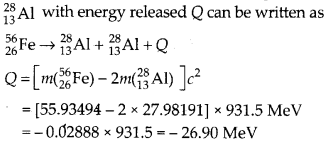
As the Q-value is negative, the fission is not possible energycally.
Question 17.
The fission properties of

are very similar to those of

. The average energy released per fission is 180 MeV. How much energy, in MeV, is released if all the atoms in 1 kg of pure

undergo fission?
Solution:
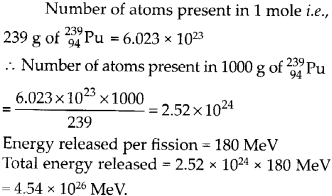
Question 18.
A 1000 MW fission reactor consumes half of its fuel in 5.00 y. How much

did it contain initially? Assume that the reactor operates 80% of the time and that all the energy generated arises from the fission of

and that this nuclide is consumed by the fission process.
Solution:
In the fission of one nucleus of

, energy generated is 200 MeV.
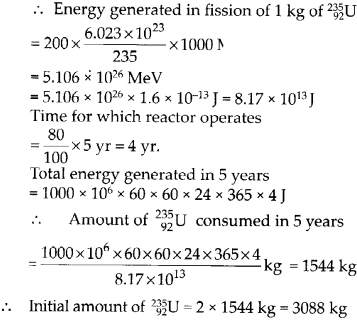
Question 19.
How long can an electric lamp of 100 W be kept glowing by fusion of 2.0 kg of deuterium? Take the fusion reaction as

Solution:
Number of atoms present in 2 g of deuterium = 6.023 × 1023 Total number of atoms present in 2000 g of deuterium

Energy released in the fusion of 2 deuterium atoms = 3.27 MeV

Question 20.
Calculate the height of potential barrier for a head-on collision of two deuterons. The effective radius of deuteron can be taken to be 2fm.
Solution:
For head on collision, distance between centers of two deuterons
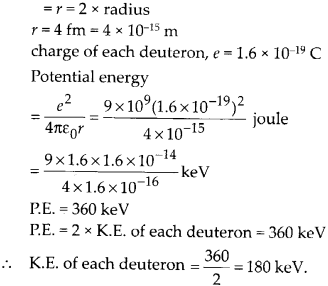
This is a measure of height of coulomb barrier.
Question 21.
From the relation R = R0 A1/3, where R2 is a constant and A is the mass number of a nucleus, show that the nuclear matter density is nearly constant (i.e., independent of A).
Solution:

As R is constant, p is contact so, nuclear density is constant irrespective of mass number or size.
Question 22.
For the β+ (positron) emission from a nucleus, there is another competing process known as electron capture (electron from an inner orbit, say, the /(-shell, is captured by the nucleus and a neutrino is emitted).

Show that if β+ emission is energetically allowed, electron capture is necessarily allowed but not vice-versa.
Solution:
Let us first consider positron emission.
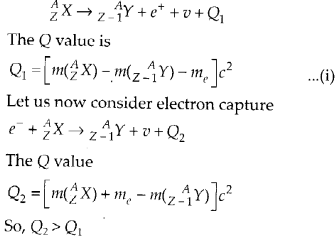
This mean if Q1 > 0 then Q2 > 0 but vice vesa is not necessarily allowed. So, electron capture is not necessary for positron emission.
Question 23.
In a periodic table the average atomic mass of magnesium is given as 24.312 u. The average value is based on their relative natural abundance on earth. The three isotopes and their masses are  (23.98504 u),
(23.98504 u),

(24.98584 u) and

(25.98259 u).The natural abundance of

78.99% by mass. Calculate the abundances of the other two isotopes.
Solution:
Let the abundance of isotope

is

Question 24.
The neutron separation energy is defined as the energy required to remove a neutron from the nucleus. Obtain the neutron separation energies of the nuclei

and

from
the following data:
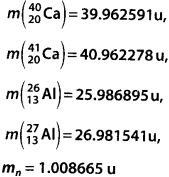
Solution:
Neutron separation of

can be obtained as E = Energy equivalent of total mass afterward – Energy equivalent of nucleus before

Question 25.
A source contains two phosphorus radio -nuclides

(T1/2 = 14.3 days) and

(Tv2 = 25.3 days). Initially, 10% of the decays come from

How long one must wait until 90% do so?
Solution:
In the mixture of P-32 and P-33 initially 10% decay came from P-33. Hence initially 90% of the mixture is P-32 and 10% of the mixture is P-33. Let after time’t’ the mixture is left with 10% of P-32 and 90% of P-33. Half life of both P-32 and P-33 are given as 14.3 days and 25.3 days respectively. Let V be total mass undecayed initially and ‘y’ be total mass undecayed finally. Let initial number of P-32 nuclides = 0.9 x Final number of P-32 nuclides = 0.1 y Similarly, initial number of P-33 nuclides = 0.l x Final number of P-33 nuclides = 0.9 y For isotope P-32
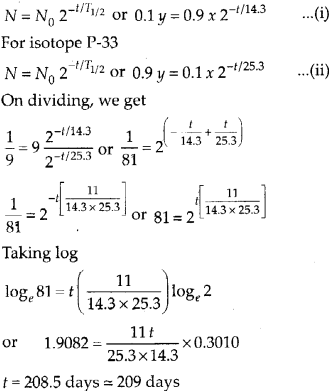
Question 26.
Under certain circumstances, a nucleus can decay by emitting a particle more massive than an a-partide. Consider the following decay processes:

Calculate the Q-values for these decays and determine that both are energetically allowed.
Solution:
Let us calculate Q value for the given decay process. For first decay process
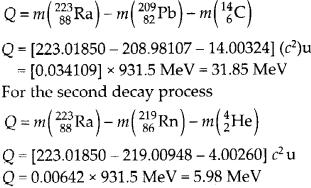
Since, Q value is positive in both the cases, hence decay process in both ways are possible
Question 27.
Consider the fission of

by fast neutrons. In one fission event, no neutrons are emitted and the final end products, after the beta decay of the primary fragments are

and

. Calculate Q for this fission process. The relevant atomic and particle masses are:

Solution:
The fission of U-238 by fast neutrons into fragments Ce-140 and Ru-99 with energy released Q can be written as

Question 28.
Consider the D-T reaction (deuterium – tritium fusion)

(a) Calculate the energy released in MeV in this reaction from the data
m

= 2.014102 u, m

= 3.016049 u
(b) Consider the radius of both deuterium and tritium to be approximately 2.0 fm. What is the kinetic energy needed to overcome the coulomb repulsion between the two nuclei? To what temperature must the gases be heated to initiate the reaction?
Solution:
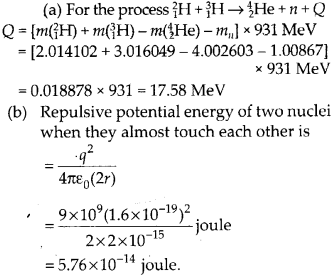
Classically, K.E. at least equal to this amount is required to overcome Coulomb repulsion. Using the relation

Question 29.
Obtain the maximum kinetic energy of β-particles and the radiation frequencies of y-decays in the decay scheme shown in figure. You are given that

= 197.968233 u,

= 197.966760 u

Solution:
Energy corresponding to y1

Question 30.
Calculate and compare the energy released by
(a) fusion of 1.0 kg of hydrogen deep within the Sun and
(b) the fission of 1.0 kg of 235U in a fission reactor.
Solution:
(a) In the fusion reactions taking place within core of sun, 4 hydrogen nuclei combines to form a helium nucleus with the release of 26 MeV of energy.
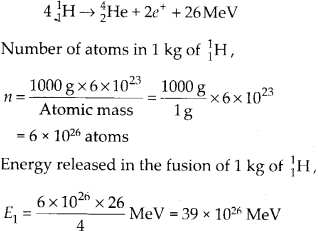
(b) Energy released per fission of U-235 is 200 MeV.

So the energy released in fusion of 1 kg of Hydrogen is nearly 8 times the energy released in fission of 1 kg of uranium-235.
Question 31.
Suppose India has a target of producing by 2020 AD, 200,000 MW of electric power, ten percent of which is to be obtained from nuclear power plants. Suppose we are given that, on an average, the efficiency of utilization (/.e., conversion to electric energy) of thermal energy produced in a reactor was 25%. How much amount of fissionable uranium would our country need per year? Take the heat energy per fission of 235U to be about 200 MeV.
Solution:
10% of total power 200,000 MW to be obtained from nuclear power plant by 2020 AD.

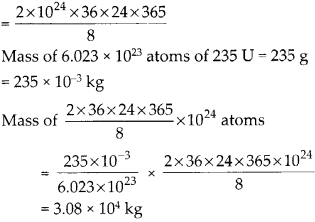
Hence mass of uranium needed per year = 3.08 × 104 kg
NCERT Solutions for 12th Class Physics: Chapter 13: Download PDF
NCERT Solutions for 12th Class Physics: Chapter 13-Nuclei
Download PDF: NCERT Solutions for 12th Class Physics: Chapter 13-Nuclei PDF
Chapterwise NCERT Solutions for Class 12 Physics :
- Chapter 1: Electric Charges and Fields
- Chapter-2: Electrostatic Potential and Capacitance
- Chapter 3: Current Electricity
- Chapter 4: Moving Charges and Magnetism
- Chapter 5: Magnetism and Matter
- Chapter 6: Electromagnetic Induction
- Chapter 7: Alternating Current
- Chapter 8: Electromagnetic Waves
- Chapter 9: Ray Optics And Optical Instruments
- Chapter 10: Wave Optics
- Chapter 11: Dual Nature Of Radiation And Matter
- Chapter 12: Atoms
- Chapter 13: Nuclei
- Chapter 14: Semiconductor Electronics Materials Devices And Simple Circuit
- Chapter 15: Communication Systems
About NCERT
The National Council of Educational Research and Training is an autonomous organization of the Government of India which was established in 1961 as a literary, scientific, and charitable Society under the Societies Registration Act. Its headquarters are located at Sri Aurbindo Marg in New Delhi. Visit the Official NCERT website to learn more.
